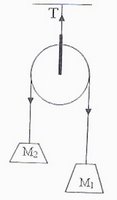The following multiple choice questions appeared in Kerala Engineering Entrance 2008 question paper:
(1) A particle of mass 2 kg is initially at rest. A force acts on it whose magnitude changes with time. The force time graph is shown below

The velocity of the particle after 10 s is
(a) 20 ms–1
(b) 10 ms–1
(c) 75 ms–1
(d) 26 ms–1
(e) 50 ms–1
The area under the force-time graph gives the impulse received which is equal to the change in momentum of the particle. Since the initial momentum of the particle is zero, the area under the graph gives the momentum of the particle after 10 s.
The area under the curve is made of rectangles and triangles and is equal to100 newton second. [Note that Ns is the same as kg ms–1].
The velocity of the particle after 10 s = (100 kg ms–1)/2 kg = 50 ms–1
(2) An object of mass 5 kg is attached to the hook of a spring balance and the balance is suspended vertically from the roof of a lift. The reading on the spring balance when the lift is going up with with an acceleration of 0.25 ms–2 is (g = 10 ms–2)
(a) 51.25 N
(b) 48.75 N
(c) 52.75 N
(d) 47.25 N
(e) 55 N
The weight of a body of mass ‘m’ in a lift can be remembered as m(g-a) in all situations if you apply the proper sign to the acceleration ‘a’ of the lift. The acceleration due to gravity ‘g’ always acts vertically downwards and its sign is to be taken as positive. Since the lift is moving upwards the sign of its acceleration is negative so that the weight of the object as indicated by the spring balance is m[g-(-a)] = m(g+ a) = 5×10.25 = 51.25 N.
(3) A bullet of mass 0.05 kg moving with a speed of 80 ms–1 enters a wooden block and is stopped after a distance of 0.4 m. The average resistance force exerted by the block on the bullet is
(a) 300 N
(b) 20 N
(c) 400 N
(d) 40 N
(e) 200 N
The bullet is retarded within the wooden block. The retardation is given by the usual equation of uniformly accelerated motion, v2 = u2 + 2as. Here v = 0, u = 80 ms–1 and s = 0.4 m.
Therefore, 0 = 802 + 2a×0.4 from which a = – 8000 ms–2
The retardation is 8000 ms–2 and the resistance force exerted by the wooden block is 0.05×8000 = 400 N.




